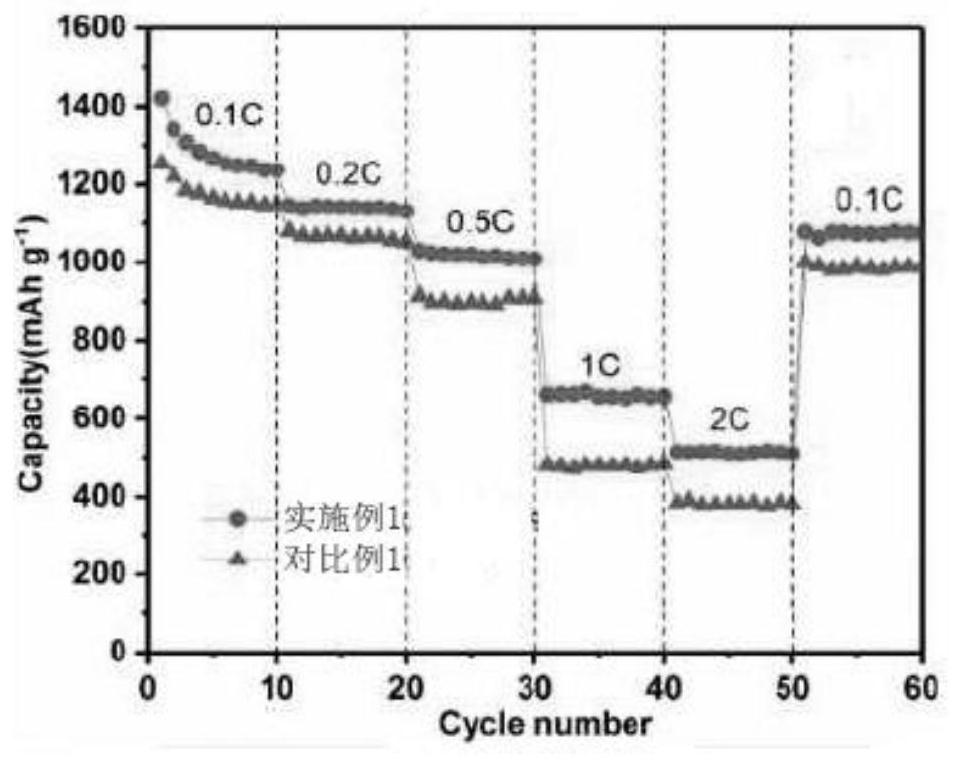Preparation method of lithium-sulfur battery electrode material
An electrode material, lithium-sulfur battery technology, applied in battery electrodes, sulfur preparation/purification, lithium storage batteries, etc. Effects of improved chemical properties, enhanced kinetic processes, good electrochemical performance
- Summary
- Abstract
- Description
- Claims
- Application Information
AI Technical Summary
Problems solved by technology
Method used
Image
Examples
Embodiment 1
[0023] A preparation method of a lithium-sulfur battery electrode material, specifically comprising the steps of:
[0024] S1: Add cetyltrimethylammonium bromide to anhydrous methanol, ultrasonically dissolve, and then add carbon nanotubes, wherein the mass ratio of cetyltrimethylammonium bromide and carbon nanotubes is 1: 140, continue ultrasonic stirring, and then add cobalt nitrate hexahydrate for ultrasonication to obtain solution A.
[0025] S2: 2-methylimidazole is added to anhydrous methanol solution, ultrasonically obtains a transparent solution B, and then solution A is quickly added to solution B, wherein the mass ratio of cobalt nitrate hexahydrate and 2-methylimidazole is 1: 0.92, the mass ratio of carbon nanotubes to cobalt nitrate hexahydrate was 1:0.35; stirred at room temperature for 3 hours, centrifuged, filtered, washed with ethanol solution 3 times, and dried at 60°C to obtain product Ⅰ.
[0026] S3: Add the product I in step S2 to the absolute ethanol solu...
Embodiment 2
[0030] A preparation method of a lithium-sulfur battery electrode material, specifically comprising the steps of:
[0031] S1: Add cetyltrimethylammonium bromide to anhydrous methanol, ultrasonically dissolve, and then add carbon nanotubes, wherein the mass ratio of cetyltrimethylammonium bromide and carbon nanotubes is 1: 165, continue ultrasonic stirring, and then add cobalt nitrate hexahydrate to obtain solution A.
[0032] S2: 2-methylimidazole is added to anhydrous methanol solution, ultrasonically obtains a transparent solution B, and then solution A is quickly added to solution B, wherein the mass ratio of cobalt nitrate hexahydrate and 2-methylimidazole is 1: 1.06, the mass ratio of carbon nanotubes to cobalt nitrate hexahydrate was 1:0.44; the reaction was stirred at room temperature for 6 hours, centrifuged, filtered, washed with ethanol solution 3 times, and dried at 70°C to obtain product I.
[0033] S3: Add the product I in step S2 to the absolute ethanol solutio...
Embodiment 3
[0037] A preparation method of a lithium-sulfur battery electrode material, specifically comprising the steps of:
[0038] S1: Add cetyltrimethylammonium bromide to anhydrous methanol, ultrasonically dissolve, and then add carbon nanotubes, wherein the mass ratio of cetyltrimethylammonium bromide and carbon nanotubes is 1: 150, continue ultrasonic stirring, and then add cobalt nitrate hexahydrate for ultrasonication to obtain solution A.
[0039] S2: 2-methylimidazole is added to anhydrous methanol solution, ultrasonically obtains a transparent solution B, and then solution A is quickly added to solution B, wherein the mass ratio of cobalt nitrate hexahydrate and 2-methylimidazole is 1: 0.96, the mass ratio of carbon nanotubes to cobalt nitrate hexahydrate was 1:0.38; the reaction was stirred at room temperature for 4 hours, centrifuged, filtered, washed with ethanol solution 3 times, and dried at 60°C to obtain product Ⅰ.
[0040] S3: Add the product I in step S2 to the abso...
PUM
 Login to View More
Login to View More Abstract
Description
Claims
Application Information
 Login to View More
Login to View More - R&D
- Intellectual Property
- Life Sciences
- Materials
- Tech Scout
- Unparalleled Data Quality
- Higher Quality Content
- 60% Fewer Hallucinations
Browse by: Latest US Patents, China's latest patents, Technical Efficacy Thesaurus, Application Domain, Technology Topic, Popular Technical Reports.
© 2025 PatSnap. All rights reserved.Legal|Privacy policy|Modern Slavery Act Transparency Statement|Sitemap|About US| Contact US: help@patsnap.com



